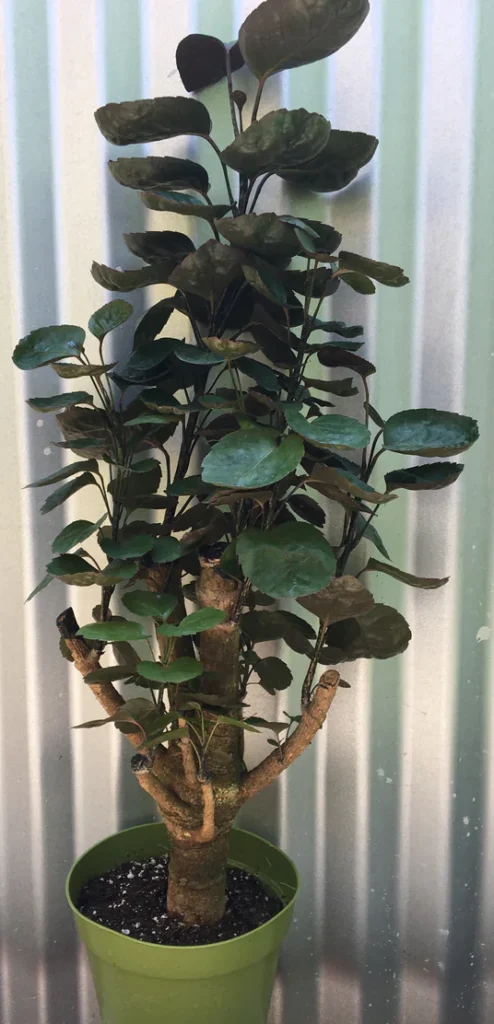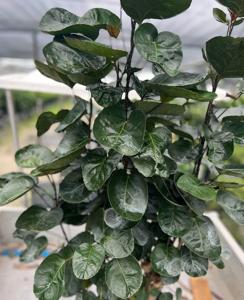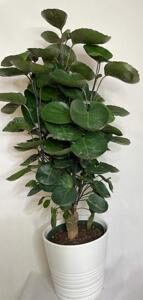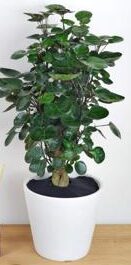How to Keep Your Aralia Fabian Healthy: Simple Care Tips

Introduction to Aralia Fabian
Aralia Fabian, are known as Polyscias Scutellari. This rare Araliaceae family member is prized for its, shield-shaped leaves.
What is Aralia Fabian?
Aralia Fabian is a tropical evergreen shrub. It is native to the Pacific Islands and parts of Southeast Asia. It’s characterized by its:
- Large, glossy leaves
- Upright growth habit
- Versatility as an indoor or outdoor plant
The plant’s most distinctive feature is its foliage. It consists of rounded, slightly cupped leaves that resemble shields or shallow bowls. This unique leaf structure is what gives Polyscias Scutellaria its name. The “shield aralia.”
Common Names and Synonyms
Aralia Fabian and Polyscias Scutellaria are the most recognized names for this plant. It also goes by several other monikers:
- Balfour Aralia
- Dinner Plate Aralia
- Shield Aralia
- Plum Aralia (for varieties with purple foliage)
Brief History and Origin
The Aralia Fabian has a rich history rooted in its native tropical habitats. Originally found in:
- The Pacific Islands
- Indonesia
- Parts of Southeast Asia
Polyscias Scutellaria often grows as a small tree or large shrub. It reaches heights of up to 10-15 feet (3-4.5 meters).
The plant was introduced to Western horticulture in the late 19th century. It is gaining popularity as a houseplant due to its attractive foliage. Aralia Fabian is grown worldwide. It is a staple in interior landscaping and home decor.
Botanical Characteristics of Polyscias Scutellaria
Plant Description
Aralia Fabian is a visually striking plant known for its:
- Height: In ideal conditions, it can grow up to 10-15 feet (3-4.5 meters) tall indoors. It can kept smaller through pruning
- Spread: Can reach 3-6 feet (0.9-1.8 meters) wide
- Growth Rate: Moderate to fast, especially in optimal conditions
- Lifespan: Perennial, with proper care, it can live for many years
Polyscias Scutellaria has an upright, somewhat tree-like growth. It gives it a distinct appearance. It features a woody stem that becomes more prominent as the plant matures.
Leaf Structure and Appearance
The most distinctive feature of Aralia Fabian is its foliage.
- The shape is large and rounded, with a slight curve that resembles a shield or a shallow bowl.
- Size: Leaves can reach 4-8 inches (10-20 cm) in diameter
- Texture: Glossy and leathery to the touch
- Color: Deep green, though variegated and purple varieties exist
- Arrangement: Alternate leaf arrangement along the stems
The edges of the leaves are wavy or have a subtle serrated texture. The leaf surface is usually smooth, with prominent veining.
Notable Varieties:
- “Marginata” – features cream or white leaf margins
- “Balfourii” – has mottled cream and green leaves
- “Fabian’s Pride” – displays darker green leaves with a more pronounced cup shape
Growth Habits
Aralia Fabian exhibits several interesting growth characteristics:
- Vertical Growth: The plant grows upright, forming a slender, tree-like structure.
- Branching: Polyscias Scutellaria tends to branch out, creating a fuller appearance.
- Leaf Density: Foliage is dense, especially at the top of the plant.
- Root System: Develop a robust root system that can become pot-bound. It will need repotting.
Aralia Fabian can grow quite tall and develop a more tree-like form. When grown indoors or as a container plant, its growth is restrained. It can be further controlled through regular pruning.

Flowering and Fruiting
Aralia Fabian is grown for its foliage. It can produce flowers and fruits under certain conditions:
- Flowers: Small, greenish-white flowers may appear on mature plants in their natural habitat
- Blooming Season: Typically in summer, though flowering is rare in indoor specimens
- Fruits: Small, round berries may follow the flowers. But, they are seldom seen on cultivated plants.
Note that flowering and fruiting are not common in indoor Polyscias Scutellaria plants. The energy of the plant is directed towards foliage growth.
Natural Habitat of Aralia Fabian
To care for Aralia Fabian (Polyscias Scutellaria), you must know its natural habitat. This knowledge helps recreate conditions that mimic its native environment.
Geographic Distribution
Aralia Fabian is native to a range of tropical regions, including:
- Pacific Islands: Particularly prevalent in Polynesia and Melanesia
- Southeast Asia: Found in countries like Indonesia, Malaysia, and the Philippines
- Northern Australia: Occurring in some tropical parts of Queensland
In these areas, Polyscias Scutellaria thrives in:
- Coastal forests
- Lowland rainforests
- Disturbed forest edges
Climate Preferences
Aralia Fabian has specific climate preferences:
- Temperature:
- Optimal range: 60-85°F (15-29°C)
- Can tolerate brief periods down to 50°F (10°C)
- Prefers consistent temperatures without dramatic fluctuations
- Humidity:
- Thrives in high humidity environments (60-80%)
- Adaptable to moderate humidity levels when grown indoors
- Rainfall:
- Native regions receive 60-80 inches (1500-2000 mm) of annual rainfall
- Prefers consistent moisture but can tolerate short dry periods
- Sunlight:
- Adapted to dappled sunlight or partial shade in its natural habitat
- Can tolerate full sun in cooler climates

Natural Growing Conditions
Polyscias Scutellaria grow under specific conditions that we can replicate:
- Soil Type:
- Well-draining, humus-rich soil
- Acidic to neutral pH (6.1 to 7.5)
- Often grows in volcanic or limestone-derived soils
- Light Exposure:
- Grows under the canopy of larger trees
- Receives filtered or dappled sunlight
- Tolerates some direct sun, especially morning light
- Air Circulation:
- Enjoys good air movement
- Helps prevent fungal issues in its humid native environment
- Companion Plants: Aralia Fabian often grows with other tropical plants, such as:
- Various fern species
- Palms
- Other Araliaceae family members
- Growth Pattern:
- In nature, can grow into small trees up to 15-20 feet (4.5-6 meters) tall
- Often forms part of the understory in tropical forests
Cultivating Aralia Fabian at Home
Light Requirements
The right amount of light is crucial for the health and growth of your Polyscias Scutellaria:
- Optimal light conditions:
- Bright, indirect light is ideal
- Can tolerate moderate to low light, but growth may slow
- Avoid harsh, direct sunlight, especially during peak afternoon hours
- Light intensity guide:
- 70-85% shade is optimal for outdoor plants
- For indoor plants, place near an east or north-facing window
Dealing with low light situations:
- Use artificial grow lights to supplement natural light
- Rotate the plant to ensure even growth
- Consider variegated varieties, which often tolerate lower light better
Watering Needs
Proper watering is essential for maintaining a healthy Aralia Fabian:
- Frequency of watering:
- Water when the top 1-2 inches (2.5-5 cm) of soil feels dry
- This means watering once or twice a week
- Reduce watering frequency in winter when growth slows
- Watering technique:
- Water until it drains from the bottom of the pot
- Empty the drainage tray to prevent water stagnation
Signs of overwatering:
- Yellowing leaves
- Soft, mushy stems
- Mold on soil surface
Signs of underwatering:
- Drooping or wilting leaves
- Dry, crispy leaf edges
- Slow growth
Remember: It’s better to underwater than to overwater. Aralia Fabian is more tolerant of short dry spells than prolonged wet conditions.
Soil and Potting
The right soil mix and potting practices are important for the health of your plant:
Ideal soil composition:
- Well-draining potting mix
- Rich in organic matter
- pH range of 6.1 to 7.5 (acidic to neutral)
Potting mix recipe:
- 2 parts quality potting soil
- 1 part perlite or coarse sand
- 1 part peat moss or coco coir
Repotting frequency and process:
- Repot every 2-3 years or when rootbound
- Choose a pot 1-2 inches (2.5-5 cm) larger in diameter
- Ensure the new pot has adequate drainage holes
- Loosen roots when repotting to encourage new growth
Pro tip: Add a layer of orchid bark to the bottom of the pot to improve drainage and aeration.

Temperature and Humidity
Aralia Fabian thrives in conditions like its tropical origin:
Optimal temperature range:
- Daytime: 70-85°F (21-29°C)
- Nighttime: Not below 60°F (15°C)
- Can tolerate brief periods down to 50°F (10°C), but not recommended
Humidity requirements:
- Prefers high humidity (60-80%)
- Can adapt to average household humidity, but will appreciate extra moisture
Methods to increase humidity:
- Use a pebble tray filled with water
- Group plants together to create a microclimate
- Mist leaves in the morning
- Use a room humidifier
Caution: Avoid placing your Aralia Fabian near heating vents or air conditioning units. They can cause temperature fluctuations and dry air.
Fertilization
Proper fertilization ensures your Polyscias Scutellaria maintains lush, healthy growth:
Types of fertilizers suitable for Aralia Fabian:
- Balanced, water-soluble fertilizer (e.g., 10-10-10)
- Slow-release granular fertilizer
- Organic options like fish emulsion or seaweed extract
Fertilization schedule:
- Feed every 2-4 weeks during the growing season (spring and summer)
- Reduce or stop fertilization in fall and winter
- Always follow package instructions for dosage
Pro tip: If using a liquid fertilizer, apply it to moist soil to prevent root burn.
Pruning and Shaping Polyscias Scutellaria
Prune and shape to maintain the health of your Aralia Fabian (Polyscias Scutellaria). These practices control the plant’s size, promoting bushier growth and attractive form.
When to Prune
- Best season: Early spring, before the active growing season begins
- Frequency: 1-2 times per year for maintenance, more for shaping
- Growth indicators: Prune when the plant becomes leggy or too tall for its space
Note: Spring pruning is ideal. Light pruning year-round if necessary to remove damaged or diseased parts.
Techniques for Shaping
Shaping your Polyscias Scutellaria helps maintain its compact form and encourage fuller growth:
- Pinching:
- Pinch off new growth at the tips of branches to encourage branching
- Use your thumb and forefinger to remove the soft, new growth
- Heading back:
- Cut back longer branches to a leaf node or bud
- This technique helps control height and promotes bushier growth
- Thinning:
- Remove entire branches back to the main stem
- Improves air circulation and light penetration within the plant
- Crown reduction:
- Reduce the size of the plant by cutting back the main stems
- Use this technique only when necessary
Pro tip: Always make cuts at a 45-degree angle. Cut above a leaf node to promote healing and prevent water from pooling on the cut surface.
Tools Needed
Having the right tools ensures clean cuts and reduces the risk of damage or disease:
- Pruning shears: For small branches up to 1/4 inch in diameter
- Loppers: For thicker branches up to 1 inch in diameter
- Pruning saw: For rare cases when you need to remove very thick, woody stems
- Disinfectant: Isopropyl alcohol or a diluted bleach solution to sterilize tools between cuts
Important: Always clean and sterilize your tools before and after use. This will prevent the spread of diseases.
Common Pests and Diseases of Aralia Fabian
The Aralia Fabian is resistant to pests and diseases. Early identification and treatment are important to a healthy plant.
Identification of Common Issues
- Pests:
- Spider mites: Tiny specks on leaves, fine webbing
- Mealybugs: White, cottony masses on stems and leaf joints
- Scale insects: Small, round, brownish bumps on stems and leaves
- Aphids: Small, soft-bodied insects clustered on new growth
- Diseases:
- Root rot: Wilting, yellowing leaves; soft, brown roots
- Leaf spot: Brown or black spots on leaves
- Powdery mildew: White, powdery coating on leaves
Prevention Methods
Preventing issues is always easier than treating them:
- Maintain proper care: Follow optimal watering, light, and humidity guidelines
- Quarantine new plants: Keep new additions isolated for a few weeks.
- Regular inspection: Check your plant weekly for signs of pests or diseases
- Good air circulation: Ensure adequate spacing between plants
- Clean environment: Keep the area around your plant clean and free of debris
Treatment Options
If your Aralia Fabian does develop issues, here are some treatment options:
- For pests:
- Neem oil: Apply a diluted neem oil solution to affected areas
- Insecticidal soap: Use on mealybugs, aphids, and spider mites
- Rubbing alcohol: Dab on individual scale insects
- Pruning: Remove infested parts of the plant
- For diseases:
- Improve drainage: For root rot, repot in fresh, well-draining soil
- Fungicides: Use for leaf spot or powdery mildew
- Reduce humidity: For fungal issues, decrease humidity and improve air circulation

Conclusion
Let’s recap the key points about Polyscias Scutellaria care:
- Light: Bright, indirect light is ideal; avoid harsh, direct sunlight
- Water: Keep soil moist but not waterlogged; allow top layer to dry between waterings
- Soil: Well-draining, rich potting mix with a pH of 6.1 to 7.5
- Temperature: Thrives in 60-85°F (15-29°C); protect from cold drafts
- Humidity: Prefers high humidity (60-80%); misting or using a humidifier can help
- Fertilizer: Feed every 2-4 weeks during growing season with a balanced fertilizer
- Pruning: Shape and maintain in early spring; regular pinching promotes bushier growth
- Pest and disease management: Treat issues if they arise
Aralia Fabian is a versatile and attractive plant. It can add a touch of tropical elegance to any space.